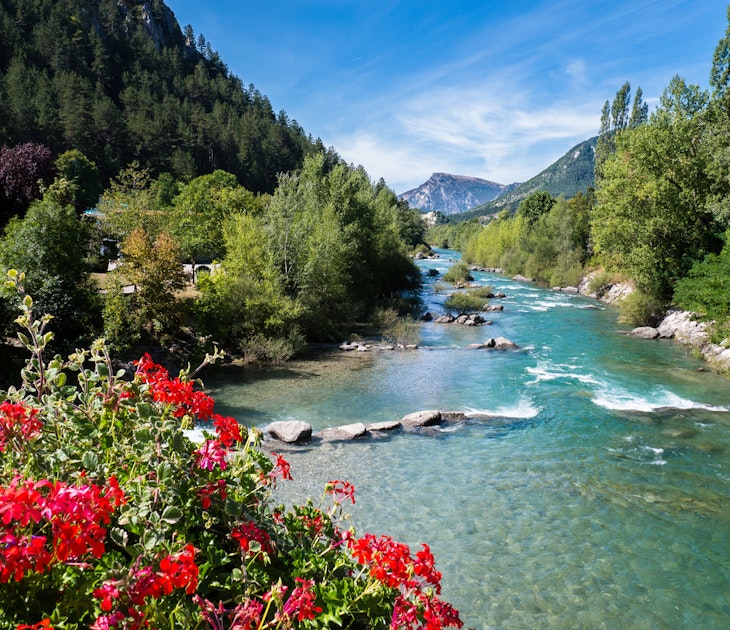
D-Day: how to explore the Normandy beaches on the 75th anniversary
Jun 4, 2019 вҖў 5 min read

The remains of a Mulberry Harbour (artificial port) at Arromanches-les-Bains in Normandy. Bertl123 / Shutterstock
6 June marks the 75th anniversary of the D-Day beach landings, the largest seaborne invasion in history. Early on the morning of 6 June 1944, swarms of landing craft arrived on the beaches of northern Normandy in France, and 135,000 Allied soldiers started to pour onto French soil.
The 80km stretch of beaches, north of Bayeux, were code-named (from west to east) Utah, Omaha, Gold, Juno and Sword. HereвҖҷs the story of the D-Day landings and how you can visit the beaches yourself.

Why did D-Day happen?
In early 1944, an Allied invasion of occupied France seemed inevitable. HitlerвҖҷs disastrous campaign in Russia and inability to control the skies over Europe had left Germany vulnerable, and both sides knew a landing was coming. After long deliberation, it was decided that the beaches along Normandy's northern coast вҖ“ rather than the even more heavily fortified coastline further north around Calais, where Hitler was expecting an attack вҖ“ would be a surprise spearhead into Europe.
Code-named вҖҳOperation OverlordвҖҷ, the invasion began on the night of 5 June 1944 when three paratroop divisions were dropped behind enemy lines. At about 6.30am on the morning of 6 June, six amphibious divisions stormed ashore at five beaches, backed up by 6000 sea craft and 13,000 aeroplanes.
What does the D in D-Day stand for?
The D in D-Day stands simply for вҖҳDayвҖҷ, the designation given to the day of any significant military operation. The day before was known as D-1, the day after as D+1, and so on.

Omaha Beach
The assault by the US infantry on Omaha Beach (the 7km stretch of coastline around Vierville-sur-Mer, St-Laurent-sur-Mer and Colleville-sur-Mer) was by far the bloodiest of the day. From the outset, the AlliesвҖҷ best-laid plans were thrown into chaos. The beach was heavily defended by three battalions of heavily armed, highly trained Germans supported by mines, underwater obstacles and an extensive trench system. Strong winds blew many of the landing craft far from their carefully planned landing sectors. Some troops, overloaded with equipment, disembarked in deep water and almost immediately drowned; others were cut to pieces by machine-gun and mortar fire from the cliffs. Only two of the 29 tanks expected to support the troops made it to shore and it proved almost impossible to advance up the beach as planned.
Eventually, metre by metre, the GIs gained a precarious toehold on the beach. Assisted by naval bombardment, the US troops blew through a key German strongpoint and began to move off the beach. Of 2500 American casualties sustained at Omaha Beach on D-Day, over 1000 were fatalities, most of them killed within the first hour of the landings.
Nowadays, little evidence of the events of 1944 remain, except for the harrowing American cemetery and concrete German bunkers. At very low tide you can see remnants of the Mulberry Harbour, a huge temporary port set up off the coast.
Omaha is a tranquil spot, a gorgeous golden stretch with dunes and summer houses. Look out for the yellow stripes that mark the Circuit de la Plage dвҖҷOmaha, a self-guided tour along the beach.

Utah Beach
Halfway between Bayeux and Cherbourg, Utah Beach вҖ“ the AlliesвҖҷ right (western) flank on D-Day вҖ“ stretches for 5km near the village of La Madeleine.
The US soldiers who landed here fared much better than their comrades at Omaha. Most of the landing craft came ashore in a relatively lightly defended area, and by noon the beach had been cleared and soldiers had linked up with paratroopers. By nightfall, some 20,000 men and 1700 vehicles had arrived on French soil via Utah Beach. But during the three weeks it took to get from here to Cherbourg, US forces suffered one casualty for every 10m they advanced.
D-Day events are commemorated by a number of monuments and the impressive MusГ©e du DГ©barquement de Utah Beach, a few kilometres inland in Ste-Marie du Mont.
Sword, Juno & Gold Beaches
Stretching for about 35km from Ouistreham to Arromanches, these three beaches were attacked by the British army, plus significant Canadian units and smaller groups of Commonwealth, Free French and Polish forces.

Sword Beach
At Sword Beach, initial German resistance was quickly overcome and the beach was secured within hours. Infantry pushed inland from Ouistreham to link up with paratroops, but they suffered heavy casualties as their supporting armour fell behind, trapped in a massive traffic jam on the narrow coastal roads. Despite this, they were within 5km of Caen by 4pm, but a heavy German counterattack forced them to dig in and Caen was not taken on the first day as planned.
Juno Beach
Canadian battalions landed quickly at Dune-lined Juno Beach but had to clear the Germans trench by trench before moving inland. Mines took a heavy toll on the infantry, but by noon they were south and east of Creuilly.
A Cross of Lorraine marks the spot where General Charles de Gaulle came ashore after the landings. Winston Churchill followed him on 12 June and King George VI on 16 June. The Juno Beach Centre organise tours of the beach, which include an otherwise inaccessible bunker next door.
Gold Beach
The attack by British forces at Gold Beach was at first chaotic, as unexpectedly high waters obscured German underwater obstacles. By 9am, though, Allied armoured divisions were on the beach and several brigades pushed inland. By afternoon theyвҖҷd linked up with the Juno forces and were only 3km from Bayeux.

A tour of the D-Day beaches
You can join a tour, but if youвҖҷve got a car, check out our Normandy WWII sights road trip. Or follow the D514 along the D-Day coast or several signposted routes around the battle sites вҖ“ look for вҖҳD-DayвҖ“Le ChocвҖҷ in the American sectors and вҖҳOverlord-LвҖҷAssautвҖҷ in the British and Canadian sectors.
What happened after D-Day?
By the fourth day after D-Day, the Allies held a coastal strip about 100km long and 10km deep. The German armour were drawn towards Caen, where fierce fighting continued for more than a month and reduced the city to rubble.
The prized port of Cherbourg fell to the Allies on 27 June after a series of fierce battles and by the end of July, US army units had smashed through to the border of Brittany. By mid-August, two German armies had been surrounded and destroyed and on 20 August US forces crossed the Seine at several points, around 40km north and south of Paris. Both Allied and Free French troops, led by General Charles de Gaulle, arrived on the streets of the capital on 25 August and by that afternoon the city had been liberated.
Explore related stories


 Wildlife & NatureNovel adventures: how to recreate six great literary journeys
Wildlife & NatureNovel adventures: how to recreate six great literary journeysFeb 27, 2019 вҖў 8 min read




 BeachesUltimate travel list: ПгёЫБщәПІКјҙКұҝӘҪұ's top sights in the world (21 to 30)
BeachesUltimate travel list: ПгёЫБщәПІКјҙКұҝӘҪұ's top sights in the world (21 to 30)Aug 17, 2015 вҖў 6 min read
 Wildlife & NatureUltimate travel list: ПгёЫБщәПІКјҙКұҝӘҪұ's top sights in the world (31 to 40)
Wildlife & NatureUltimate travel list: ПгёЫБщәПІКјҙКұҝӘҪұ's top sights in the world (31 to 40)Aug 17, 2015 вҖў 6 min read

